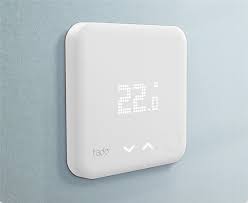Part of the ease of living comes from home systems that provide an intelligent way of controlling and managing appliances, lighting, and thermostat. Today, it is possible to set the temperature at home without manipulating any knobs or switches, and it’s possible with smart thermostats.
The smart thermostat is an innovation that lets a consumer manage the indoor temperature using an application that can be accessed on a smartphone, desktop, or tablet. It allows central heating to be operated remotely via a three-component makeup: plug to the boiler, an in-home device, and an app.
Many providers are offering new-generation smart thermostats that not only help users manage the home’s ambiance but also aid in optimising heating usage to contribute to reducing the carbon footprint. Out of the many choices, two brands worth reviewing are the Nest and Tado.

Nest Thermostat: An Overview
Net is the prime offering by Google that has headlined in 2014 and continues to be one of the biggest brands in smart thermostats. It was bought out by the technology powerhouse for £2 billion. Nest’s Smart Thermostat is designed by the creator of the iPod and is notable for adapting to the home user’s behaviour. It means that these devices can sense when the house is empty, requiring no heating.
The brand has two smart thermostat models that customers can choose depending on their preference. The Nest Learning Thermostat is the newer, third-generation flagship of the brand that offers additional features on top of the signature learning habit that identifies Nest devices. It has an upgraded design with better viewing angles and a sharper display.
The Nest Learning Thermostat not only allows control of heating, but it also lets the user manage the home’s hot water system. However, it needs to be installed by a heating engineer to ensure that it is correctly wired to the boiler.
The Nest Thermostat E is the less expensive yet adequately intelligent device that is an excellent choice for homes with an existing wired thermostat. It also learns the user’s habits and adapts the thermostat accordingly. This device is compatible with most boiler providers in the UK. It is easier to install compared to the Nest Learning Thermostat, but it does not come with hot water control and is dependent on batteries for operation.

Tado Thermostat: An Overview
Tado is a well-known name in Germany and the rest of Europe for years before it launched in October 2013 in the UK. It is similar to the Google Nest in that it is designed to adapt to the user’s living habits to ensure the smart home needs only a tiny bit of input for it to be fully operational.
The Tado Thermostat is capable of learning user behaviour to match the preference and lifestyle of the owner and create an energy-efficient heating system. It does its learning by tracking the user’s lifestyle via their smartphones. It is compatible with most boiler types and is relatively easy to install. However, in some applications, the device needs to be plugged to the boiler via an Extension Kit before it can interact with the rest of the heating system.

Along with the Extension Kit, the device also needs a Bridge (dongle), linking it to the router via the Ethernet connection. The Tado app displays the current temperature, thermostat location, and control switch to turn the heating down or up. It utilises Geofencing, wherein the device detects when there isn’t anyone in the house, thereby turning off the heating system to save money for the users. It comes with a £3 per month subscription, although it might not be ideal since you can get this service for free from Google Nest.
Another notable feature is Tado’s Open Window Detection that notifies the user when there is sudden spike or drop in humidity or temperature, which then prompts the heating to adjust accordingly. It is also possible to pair with a smart assistant to use voice control, making it a hands-free experience.
Nest versus Tado: Which is Better?
While both brands have impressive, intelligent features, there are different qualities that could appeal more depending on what the buyer is looking for in a smart thermostat. If the buying decision considers costs, Tado’s £200 Starter Kit is on par with Google Nest Thermostat E’s £199 pricing. Meanwhile, Google Nest Learning Thermostat is a bit more expensive at £219.
When it comes to features, the Nest Learning Thermostat has all the standard features than its older version and the Tado Thermostat, plus a few extras that justify its costs. For people wanting a better display (because the design is also an important parameter for buyers), the look and style of the Nest Learning Thermostat are on another level.
No matter what the user decides to purchase, the device must be compatible with the rest of the home system to ensure that not only is the price right, but the quality and functionality fit as well.
